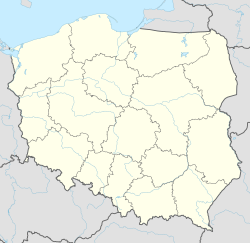Strumień
Strumień | |
|---|---|
 Town square | |
| Coordinates: 49°55′2″N 18°45′49″E / 49.91722°N 18.76361°E | |
| Country | |
| Voivodeship | |
| County | Cieszyn |
| Gmina | Strumień |
| Founded | 13th century |
| First mentioned | 1407 |
| Town rights | 1482 |
| Government | |
| • Mayor | Anna Agnieszka Grygierek |
| Area | |
• Total | 6.45 km2 (2.49 sq mi) |
| Population (2019-06-30[1]) | |
• Total | 3,718 |
| • Density | 580/km2 (1,500/sq mi) |
| Time zone | UTC+1 (CET) |
| • Summer (DST) | UTC+2 (CEST) |
| Postal code | 43-246 |
| Car plates | SCI |
| Website | http://www.strumien.pl |
Strumień [ˈstrumʲɛɲ] ⓘ (German: Schwarzwasser, Czech: Strumeň) is a town and the seat of Gmina Strumień, in Cieszyn County, in the Silesian Voivodeship (province) of southern Poland, on the Vistula River.
It is located in the north-eastern part of the historical region of Cieszyn Silesia and is the smallest town in the county.
History
[edit]The name is of topographic origin and is derived from a local stream (now non-existent) first mentioned in 1293, known as Czarny Strumień (lit. black stream, therefore Schwarzwasser in German).[2] It is not certain if the settlement already existed then as the village was first mentioned later in 1407 as Swarczenwassir.[3][2] Later the village was also mentioned as Swarczenwasser (1409), Strumienie (1450), na Strumyeny (1470), miesto Strumien (1491).[2] Politically it belonged then to the Duchy of Racibórz a fee of the Kingdom of Bohemia. During the political upheaval beginning in the 1470s caused by Matthias Corvinus the land around Pszczyna with Strumień was overtaken by Casimir II, Duke of Cieszyn, who bestowed the village to his retainer, Mikołaj (Nicolaus) Brodecki, who quickly managed to procure town rights for it in 1482. Casimir II sold Pszczyna circle in 1517 but the town of Strumień stayed within the Duchy of Teschen. In 1526 the Kingdom of Bohemia became part of the Habsburg monarchy.
In 1573–1577 the town together with Skoczów and their surrounding villages were sold to Gottard von Logau, and formed state country.[a] It was retrieved by Adam Wenceslaus in 1594.
Since 1653 it belonged to Teschener Kammer. After Revolutions of 1848 in the Austrian Empire a modern municipal division was introduced in the re-established Austrian Silesia. The town became a seat of a legal district in the political district of Bielsko. According to the censuses conducted in 1880, 1890, 1900 and 1910 the population of the town dropped from 1731 in 1880 to 1579 in 1910. In 1880 the majority of its inhabitants were native Polish-speakers (83.6%) followed by German-speakers (15.4%) and Czech-speakers (16 or 1%). In the next years the Polish-speaking population dropped down to 45% in 1910, whereas German-speaking citizens grew in number up to 54.5% in 1910, Czech-speaking persons dwindled to 8 or 0.5%. In terms of religion in 1910 majority were Roman Catholics (1484 or 94%), followed by Jews (67 or 4.2%) and Protestants (28 or 1.8%).[4][5] The town and especially its southern surroundings were also traditionally the northernmost area inhabited by Cieszyn Vlachs, speaking Cieszyn Silesian dialect. The growth of German language, then prestigious language of the state, can be partially attributed to various reasons, including cultural cringe of indigenous Slavic denizens.[6]
After World War I, fall of Austria-Hungary, Polish–Czechoslovak War and the division of Cieszyn Silesia in 1920, it became a part of Poland. Following the invasion of Poland by the German army it was annexed by Nazi Germany at the beginning of World War II (as Schwarzwasser again). After the war it was restored to Poland.
In 1975–1998 it was a part of the Bielsko-Biała Voivodeship and since 1999 it belongs to Silesian Voivodeship.
Twin towns – sister cities
[edit]See twin towns of Gmina Strumień.
Notes
[edit]References
[edit]- ^ "Population. Size and structure and vital statistics in Poland by territorial division in 2019. As of 30th June". stat.gov.pl. Statistics Poland. 2019-10-15. Retrieved 2020-02-14.
- ^ a b c Mrózek, Robert (1984). Nazwy miejscowe dawnego Śląska Cieszyńskiego [Local names of former Cieszyn Silesia] (in Polish). Katowice: Uniwersytet Śląski w Katowicach. p. 45. ISSN 0208-6336.
- ^ Panic, Idzi (2010). Śląsk Cieszyński w średniowieczu (do 1528) [Cieszyn Silesia in Middle Ages (until 1528)] (in Polish). Cieszyn: Starostwo Powiatowe w Cieszynie. p. 306. ISBN 978-83-926929-3-5.
- ^ Piątkowski, Kazimierz (1918). Stosunki narodowościowe w Księstwie Cieszyńskiem (in Polish). Cieszyn: Macierz Szkolna Księstwa Cieszyńskiego. pp. 261, 279.
- ^ Ludwig Patryn (ed): Die Ergebnisse der Volkszählung vom 31. Dezember 1910 in Schlesien, Troppau 1912.
- ^ Janusz Gruchała; Krzysztof Nowak (2013). Śląsk Cieszyński od Wiosny Ludów do I wojny światowej (1848–1918). Cieszyn: Starostwo Powiatowe w Cieszynie. p. 20. ISBN 978-83-935147-3-1.
External links
[edit]- (in Polish) Gmina Strumień Official website
- Jewish Community in Strumień on Virtual Shtetl



